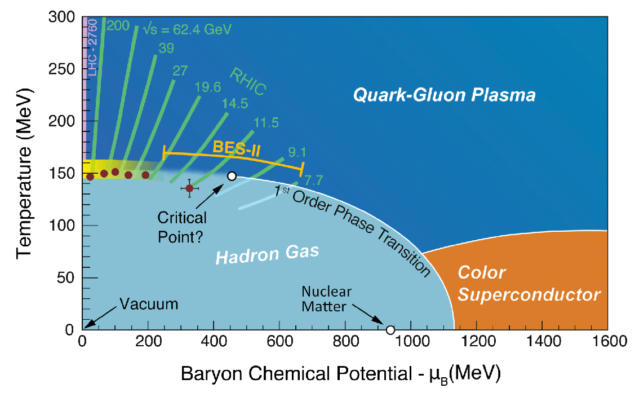
The XXXII international workshop of the Logunov Institute for High-Energy Physics of the NRC Kurchatov Institute in Protvino, near Moscow, brought more than 300 physicists together online from 9 to 13 November to discuss “hot problems in hot and cold quark matter”. The focus of the workshop was chiral theories and lattice simulations, which allow estimates beyond perturbation theory for studying the strongly coupled quark–gluon plasma (sQGP) – the hot and/or dense plasma of quarks and gluons that is created in heavy-ion collisions, and which may exist inside neutron stars.
Participants considered the QCD phase diagram (pictured) as a function of temperature, magnetic field (B), baryon and isospin chemical potentials (μB and μI), and varying quark masses. The crossover line (yellow strip), which marks a transition between hadronic matter and sQGP, has long attracted great interest. Vladimir Skokov (Brookhaven) employed recent progress in the Lee–Yang approach to phase transitions to derive from first principles that μB > 400 MeV at the critical end point (a possible termination of the first-order phase-transition boundary). Discussions of the phase diagram also included a decrease in the pseudocritical temperature with B, the possibility of a first-order phase transition at μB = 0 as B tends to infinity, the existence and location of a superconducting phase, the disagreement between measured and predicted collective flows of direct photons in heavy-ion collisions, and the diamagnetic and paramagnetic natures of the pion gas and deconfined matter, respectively. Evgeny Zabrodin (Oslo) explained that the rotating fireballs of strongly interacting matter that are produced in heavy-ion collisions are not only superfluids but also supervortical liquids.
Gravitational-wave astrophysics
Impressive work was also shared at the intersection of heavy-ion collisions and gravitational-wave astrophysics on the subject of the equation of state (EoS) of neutron-star cores. The EoS is the relationship between pressure and density, and can indicate whether hadronic or quark matter is inside. Theoretical bounds on the EoS come from chiral effective theories, perturbative QCD, and the bound on the speed of sound cs < 1/3. The quantities that can be extracted from experimental data are the mass–radius relation and the relationship between the tidal deformabilities of merging neutron stars and the peak frequency of the emitted gravitational waves. Several speakers observed that tidal deformabilities, which are measured in the inspiral phase, and the peak gravitational- wave frequency, which is measured in the post-merger phase, may together reveal the state of a neutron-star interior. Mergers observed since 2017 may already be able to shed light on the existence of a deconfined phase inside these ultra-compact objects.
Mariana Araújo offered a solution to the longstanding quarkonium polarisation puzzle
The Protvino workshop also revealed the enduring importance of studying heavy-quark physics. Since heavy quarks can be considered as approximately statically coloured sources, studies of quarkonia production are a step towards understanding hadron formation and the confinement mechanism. Peter Petreczky (Brookhaven) concluded from a lattice study of Bethe–Salpeter amplitudes that the potential model fails to describe bottomonium in terms of screened potential at high temperatures, with further investigations clearly needed in this field. Carlos Lourenço (CERN) showed that the lowering of quarkonia binding energies in the sQGP leads to nontrivial measured suppression patterns. Eric Braaten (Ohio) showed that the decrease with multiplicity of the ratio of the prompt production rates of X(3872) and Ψ(2S) in proton–proton collisions can be explained by the scattering of co-moving pions off X(3872) if it is a weakly bound charm-meson molecule. With equally impressively scrupulousness, Mariana Araújo (Innsbruck) offered a solution to the longstanding “quarkonium polarisation puzzle” by making use of a model-independent fitting procedure and taking into account correlations between cross sections and polarisations.
The next “hot problems” workshop will be held in November.








